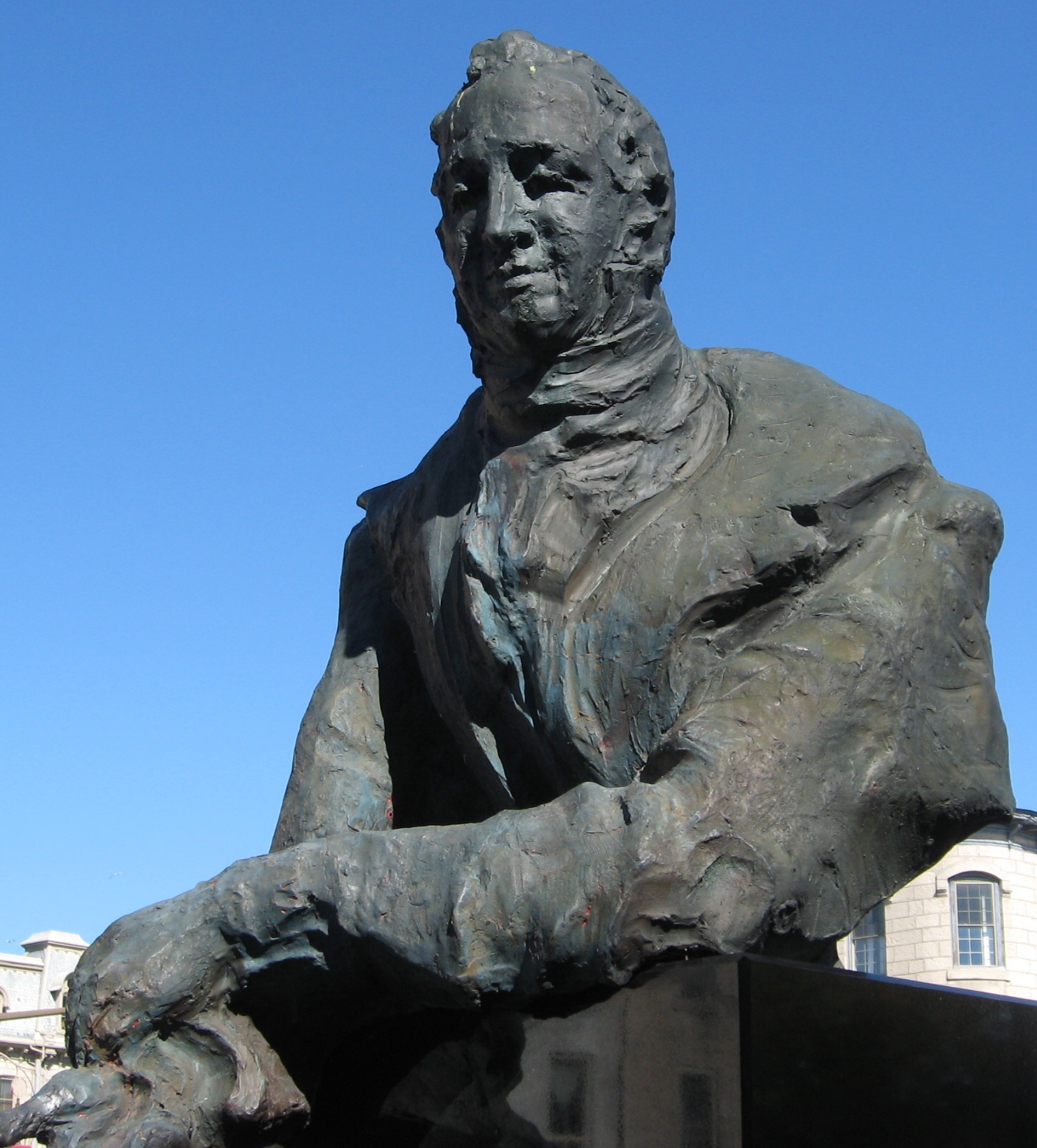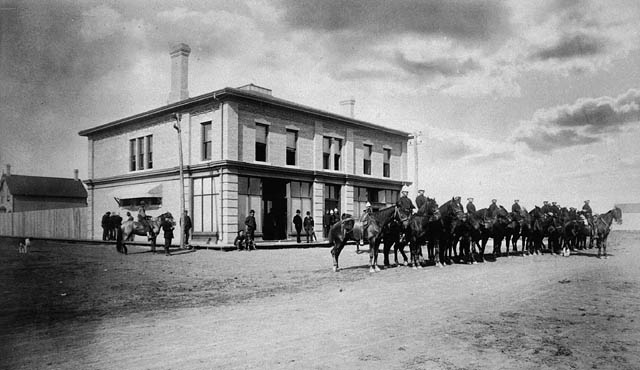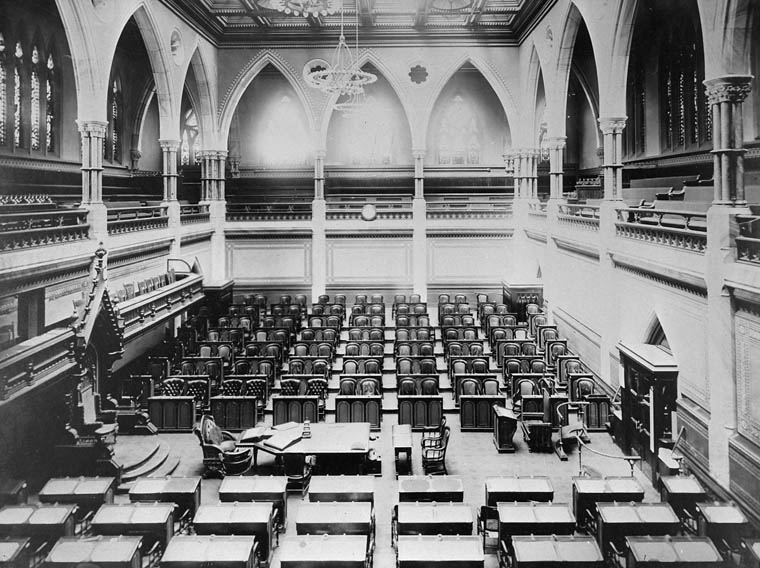|
Thomas Walter Scott
Walter Scott (full name: Thomas Walter Scott) (October 27, 1867 – March 23, 1938) was the first premier of Saskatchewan from 1905 to 1916. Scott was Saskatchewan's second longest-serving Premier, serving one continuous term from 1905 to 1916). He led the Saskatchewan Liberal Party in three general elections, winning all three with majority governments before retiring. He was the first of six Liberal Premiers to date. He was succeeded by William Melville Martin. Scott was also the minister of various departments during his tenure as premier. Prior to the creation of Saskatchewan in 1905, Scott was a Member of Parliament in the federal House of Commons, elected in the general elections of 1900 and 1904. Early life Scott was born in 1867 in London Township, Ontario, in rural southwestern Ontario, the child of George Scott and Isabella Telfer. He was born out of wedlock, a fact he kept secret for his entire life. He moved to Portage la Prairie, Manitoba in 1885, and then ... [...More Info...] [...Related Items...] OR: [Wikipedia] [Google] [Baidu] |
William Melville Martin
William Melville Martin (August 23, 1876 – June 22, 1970) served as the second premier of Saskatchewan from 1916 to 1922. In 1916, although not a member of the Legislative Assembly of Saskatchewan, Martin was elected leader of the Saskatchewan Liberal Party, succeeding Premier Walter Scott and thus became Premier of Saskatchewan. Prior to entering provincial politics, Martin had been a member of the federal Parliament for two terms, as a member of the Liberal Party of Canada. On his retirement from politics, he was appointed to the Saskatchewan Court of Appeal, serving first as a puisne justice and then as Chief Justice of Saskatchewan. Early life Martin was born in Norwich, Ontario. In 1898, he earned an honours degree in Classics from the University of Toronto, and then a Teacher Certificate from the Ontario School of Pedagogy. After teaching for two years, he attended Osgoode Hall Law School and qualified as a lawyer. In 1903, he moved to Regina and join ... [...More Info...] [...Related Items...] OR: [Wikipedia] [Google] [Baidu] |
Guelph
Guelph ( ; 2021 Canadian Census population 143,740) is a city in Southwestern Ontario, Canada. Known as "The Royal City", Guelph is roughly east of Kitchener and west of Downtown Toronto, at the intersection of Highway 6, Highway 7 and Wellington County Road 124. It is the seat of Wellington County, but is politically independent of it. Guelph began as a settlement in the 1820s, established by Scotsman John Galt, who was in Upper Canada as the first Superintendent of the Canada Company. He based the headquarters, and his home, in the community. The area – much of which became Wellington County – had been part of the Halton Block, a Crown Reserve for the Six Nations Iroquois. Galt would later be considered as the founder of Guelph. For many years, Guelph ranked at or near the bottom of Canada's crime severity list. However, the 2017 Crime Severity Index showed a 15% increase from 2016. Guelph has been noted as having one of the lowest unemployment rates in ... [...More Info...] [...Related Items...] OR: [Wikipedia] [Google] [Baidu] |
History Of Northwest Territories Capital Cities
The history of Northwest Territories capital cities begins with the purchase of the Territories by Canada from the Hudson's Bay Company in 1869, and includes a varied and often difficult evolution. Northwest Territories is unique amongst the other provinces and territories of Canada in that it has had seven capital cities in its history. The territory has changed the seat of government for numerous reasons, including civil conflict, development of infrastructure, and a history of significant revisions to its territorial boundaries. The result of these changes has been a long and complex road to responsible government. Effectively providing services and representation for the population has been a particular challenge for the Territories' government, a task often complicated by the region's vast and changing geographic area. A small number of communities in Northwest Territories have unsuccessfully tried to become the capital over the years. The territory has had the seat of gover ... [...More Info...] [...Related Items...] OR: [Wikipedia] [Google] [Baidu] |
Regina, Saskatchewan
Regina () is the capital city of the Canadian province of Saskatchewan. The city is the second-largest in the province, after Saskatoon, and is a commercial centre for southern Saskatchewan. As of the 2021 census, Regina had a city population of 226,404, and a Metropolitan Area population of 249,217. It is governed by Regina City Council. The city is surrounded by the Rural Municipality of Sherwood No. 159. Regina was previously the seat of government of the North-West Territories, of which the current provinces of Saskatchewan and Alberta originally formed part, and of the District of Assiniboia. The site was previously called Wascana ("Buffalo Bones" in Cree), but was renamed to Regina (Latin for "Queen") in 1882 in honour of Queen Victoria. This decision was made by Queen Victoria's daughter Princess Louise, who was the wife of the Governor General of Canada, the Marquess of Lorne. Unlike other planned cities in the Canadian West, on its treeless flat plain Regina h ... [...More Info...] [...Related Items...] OR: [Wikipedia] [Google] [Baidu] |
The Canadian Encyclopedia
''The Canadian Encyclopedia'' (TCE; french: L'Encyclopédie canadienne) is the national encyclopedia of Canada, published online by the Toronto-based historical organization Historica Canada, with the support of Canadian Heritage. Available for free online in both English and French, ''The Canadian Encyclopedia'' includes more than 19,500 articles in both languages on numerous subjects including history, popular culture, events, people, places, politics, arts, First Nations, sports and science. The website also provides access to the ''Encyclopedia of Music in Canada'', the ''Canadian Encyclopedia Junior Edition'', ''Maclean's'' magazine articles, and ''Timelines of Canadian History''. , over 700,000 volumes of the print version of ''TCE'' have been sold and over 6 million people visit ''TCE'''s website yearly. History Background While attempts had been made to compile encyclopedic material on aspects of Canada, ''Canada: An Encyclopaedia of the Country'' (1898–1900 ... [...More Info...] [...Related Items...] OR: [Wikipedia] [Google] [Baidu] |
Portage La Prairie, Manitoba
Portage la Prairie () is a small city in the Central Plains Region of Manitoba, Canada. As of 2016, the population was 13,304 and the land area of the city was . Portage la Prairie is approximately west of Winnipeg, along the Trans-Canada Highway (exactly halfway between the provincial boundaries of Saskatchewan and Ontario). The community sits on the Assiniboine River, which flooded the town persistently until a diversion channel north to Lake Manitoba (the Portage Diversion) was built to divert the flood waters. The city is surrounded by the Rural Municipality of Portage la Prairie. According to Environment Canada, Portage la Prairie has the most sunny days during the warm months in Canada. It is the administrative headquarters of the Dakota Tipi First Nations reserve. History Pre-colonial era Long before European settlers arrived in the mid-1800s, the Portage la Prairie area was first inhabited by several Indigenous nations (including the Anishinaabe/Ojibwe, Cree ... [...More Info...] [...Related Items...] OR: [Wikipedia] [Google] [Baidu] |
Dictionary Of Canadian Biography
The ''Dictionary of Canadian Biography'' (''DCB''; french: Dictionnaire biographique du Canada) is a dictionary of biographical entries for individuals who have contributed to the history of Canada. The ''DCB'', which was initiated in 1959, is a collaboration between the University of Toronto and Laval University. Fifteen volumes have so far been published with more than 8,400 biographies of individuals who died or whose last known activity fell between the years 1000 and 1930. The entire print edition is online, along with some additional biographies to the year 2000. Establishment of the project The project was undertaken following a bequest to the University of Toronto from businessman, James Nicholson for the establishment of a Canadian version of the United Kingdom's '' Dictionary of National Biography''. In the spring of 1959, George Williams Brown was appointed general editor and the University of Toronto Press, which had been named publisher, sent out some 10,000 ann ... [...More Info...] [...Related Items...] OR: [Wikipedia] [Google] [Baidu] |
Ontario
Ontario ( ; ) is one of the thirteen provinces and territories of Canada.Ontario is located in the geographic eastern half of Canada, but it has historically and politically been considered to be part of Central Canada. Located in Central Canada, it is Canada's most populous province, with 38.3 percent of the country's population, and is the second-largest province by total area (after Quebec). Ontario is Canada's fourth-largest jurisdiction in total area when the territories of the Northwest Territories and Nunavut are included. It is home to the nation's capital city, Ottawa, and the nation's most populous city, Toronto, which is Ontario's provincial capital. Ontario is bordered by the province of Manitoba to the west, Hudson Bay and James Bay to the north, and Quebec to the east and northeast, and to the south by the U.S. states of (from west to east) Minnesota, Michigan, Ohio, Pennsylvania, and New York. Almost all of Ontario's border with the United States f ... [...More Info...] [...Related Items...] OR: [Wikipedia] [Google] [Baidu] |
1904 Canadian Federal Election
The 1904 Canadian federal election was held on November 3, 1904 to elect members of the House of Commons of Canada of the 10th Parliament of Canada. Prime Minister Sir Wilfrid Laurier led the Liberal Party of Canada to a third term in government, with an increased majority, and over half of the popular vote. Sir Robert Borden's Conservatives and Liberal-Conservatives were unable to challenge the Liberals effectively, and lost a small portion of their popular vote, along with four seats, including his own. Borden re-entered parliament the next year in a by-election. This was the last election until 1949 in which parts of the Northwest Territories were granted representation. Most of the settled regions of the NWT entered Confederation as the provinces of Alberta and Saskatchewan on 1 September 1905, although its MP's continued to sit as representatives of the old ridings until the 10th Parliament's dissolution. One of the key issues in the election was Imperial Preference. Na ... [...More Info...] [...Related Items...] OR: [Wikipedia] [Google] [Baidu] |
1900 Canadian Federal Election
The 1900 Canadian federal election was held on November 7, 1900 to elect members of the House of Commons of Canada of the 9th Parliament of Canada. As a result of the election, the Liberal Party, led by Prime Minister Wilfrid Laurier, was re-elected to a second majority government, defeating the Conservative Party and Liberal-Conservatives led by Charles Tupper. National results Notes: * Party did not nominate candidates in the previous election. x - indicates less than 0.005% of the popular vote. 1 Ralph Smith is reported to have run as an Independent Labour candidate in Vancouver. He was elected defeating both a Liberal and Conservative, but immediately joined the Liberal Party caucus when he took his seat in the House of Commons. Some records suggest that he ran as a Liberal in 1900. He was subsequently re-elected as a "Liberal" in 1904 and 1908, and was defeated in 1911. He is listed in these tables as having been elected as a Liberal. 2 Arthur Puttee of Winnipeg ... [...More Info...] [...Related Items...] OR: [Wikipedia] [Google] [Baidu] |
House Of Commons Of Canada
The House of Commons of Canada (french: Chambre des communes du Canada) is the lower house of the Parliament of Canada. Together with the Crown and the Senate of Canada, they comprise the bicameral legislature of Canada. The House of Commons is a democratically elected body whose members are known as members of Parliament (MPs). There have been 338 MPs since the most recent electoral district redistribution for the 2015 federal election, which saw the addition of 30 seats. Members are elected by simple plurality ("first-past-the-post" system) in each of the country's electoral districts, which are colloquially known as ''ridings''. MPs may hold office until Parliament is dissolved and serve for constitutionally limited terms of up to five years after an election. Historically, however, terms have ended before their expiry and the sitting government has typically dissolved parliament within four years of an election according to a long-standing convention. In any case, an ac ... [...More Info...] [...Related Items...] OR: [Wikipedia] [Google] [Baidu] |
Majority Government
A majority government is a government by one or more governing parties that hold an absolute majority of seats in a legislature. This is as opposed to a minority government, where the largest party in a legislature only has a plurality of seats. A government majority determines the balance of power. A majority government is usually assured of having its legislation passed and rarely if ever, has to fear being defeated in parliament, a state is also known as a working majority. In contrast, a minority government must constantly bargain for support from other parties in order to pass legislation and avoid being defeated on motions of no confidence. Single-party majority governments tend be formed in the aftermath of strong election performances. The term "majority government" may also be used for a stable coalition of two or more parties to form an absolute majority. One example of such an electoral coalition is in Australia, where the Liberal and National parties have run as ... [...More Info...] [...Related Items...] OR: [Wikipedia] [Google] [Baidu] |





_-_tight_crop.jpg)
